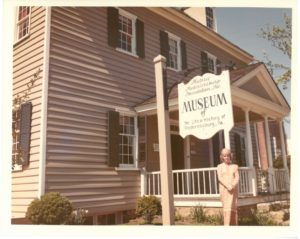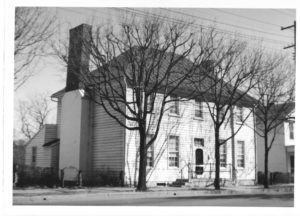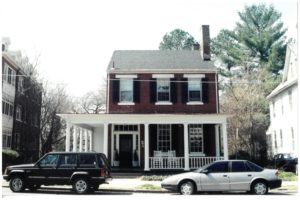It Takes a Village…To Save an Old House
It Takes a Village…To Save an Old House
By Wendy Migdal, HFFI Volunteer
Sometimes houses, like people, fall on hard times. Life throws challenges their way, and they don’t always have the resources to keep up. If they have a network of people willing to labor on their behalf, they can bounce back. If not, there isn’t much hope.
 The house at 818 Sophia Street, named the Wells House after its most famous occupant, is a success story. Built in 1812 for Reverend William James of the Fredericksburg Baptist Church, the house is a 2-1/2 story Federal style structure with walls of brick nogging covered with beaded weatherboarding, which surely stood it in good stead during the bombardment by Union forces 50 years later.
The house at 818 Sophia Street, named the Wells House after its most famous occupant, is a success story. Built in 1812 for Reverend William James of the Fredericksburg Baptist Church, the house is a 2-1/2 story Federal style structure with walls of brick nogging covered with beaded weatherboarding, which surely stood it in good stead during the bombardment by Union forces 50 years later.
The Benjamin Wells family most likely leased the house during the Civil War. Fifteen-year-old daughter Geno Wells became the subject of a wartime romance with a supposed federal spy—a story that captivated the generation following the Civil War.
By 1966, the house had served as a tenement for many years and was in a dilapidated condition. Historic Fredericksburg Foundation, Inc. (HFFI) raised $10,000 to purchase it and received another $10,000 in a special appropriation by the Virginia General Assembly. The restoration task was daunting: HFFI’s director Boyd Graves was unable to name a single thing that didn’t need work. A cinderblock kitchen and chimney added in 1940 were removed, flooring was restored or replaced, and new wiring and heating systems were installed. Even the pillars on the front porch, which had been boxed up, were returned to their original round shape.
HFFI operated the house as a museum and as its headquarters for several years. In 1975, the organization sold it to a private owner, although HFFI maintains a perpetual covenant, or easement, on the property. Since then, the house has been sold to several people who have operated businesses out of it: a bridal shop, a bakery, and most recently, an accounting firm. You can see the beautiful interiors in a marketing video on YouTube created by a realty company.

In contrast, at 1407 Caroline Street a bit of sidewalk leads to nowhere, mute testimony to the two-story Georgian style house, originally constructed about 1787, that once stood there. The Civil War was especially unkind to this home, but it appears to have been almost completely rebuilt by 2 years after the war.
However, the 21st century witnessed the demise of this house. First, a storm-related fire in 2003 damaged it, and it sat vacant for 7 years. Another fire in November 2010 struck the death knell. The following February, the city declared the structure unsafe under a state code, which gives the owner the right to tear it down. He did just that in June 2011, prompting a vigorous protest and the passionate resignation of the president of the Architectural Review Board.
But perhaps a phoenix will rise out of the ashes. Although a house has yet to be built on that site, the city and HFFI work to prevent “demolition by neglect” so there are no future irreplaceable losses. To support these efforts, become a member of HFFI by visiting HFFI.org to join.
(Also published in the March 2019 issue of the Front Porch.)



